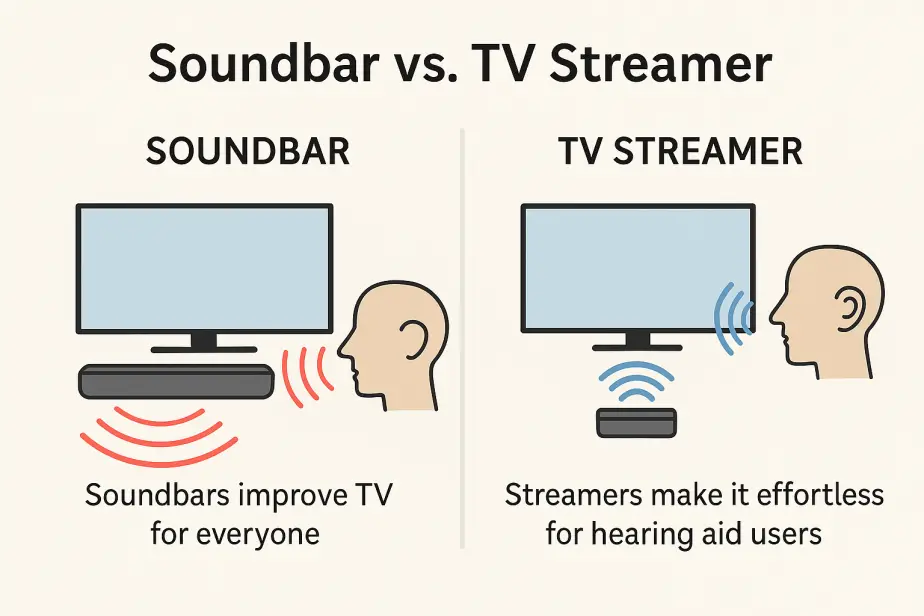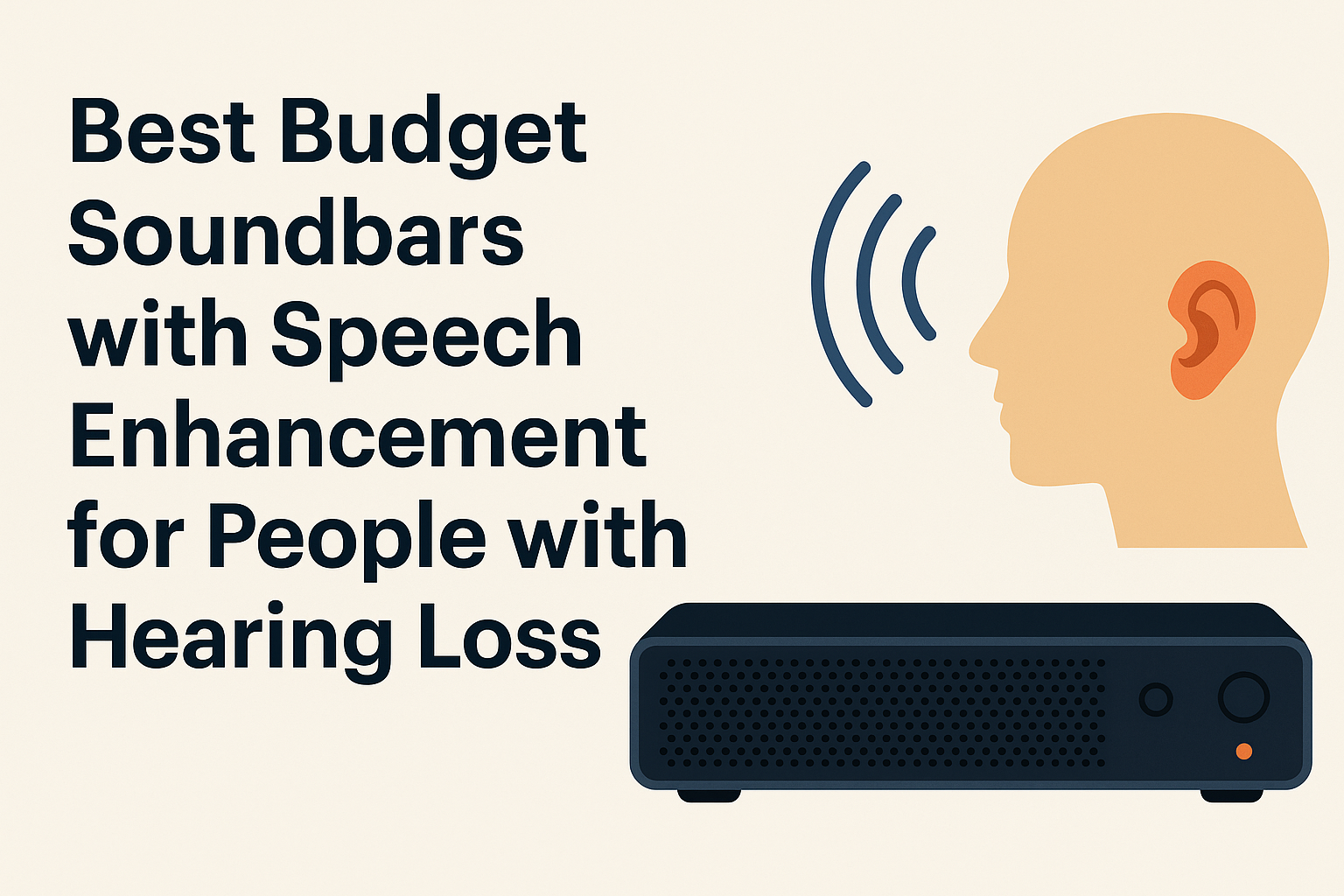Affiliate Disclosure: This article contains affiliate links. If you click through and make a purchase, I may earn a small commission at no extra cost to you. As an Amazon Associate, I earn from qualifying purchases. Your support helps keep HearingInsider.com up and running.
As an audiologist, one of the most common complaints I hear is:
“I can hear the TV just fine — I just can’t understand what they’re saying.”
If that sounds familiar, you’re not alone. Hearing loss (especially in the high frequencies) makes dialogue hard to follow even when the TV is loud. Luckily, you don’t need a full surround system to fix it — budget-friendly soundbars with speech enhancement technology can make a huge difference.
Below, I’ll walk you through my top recommended budget soundbars (under ~$200) designed to boost dialogue clarity, explain how these features work for hearing loss, and share patient examples from my clinic.
Why TV Streamers + Hearing Aids Can Make the Biggest Difference

While soundbars with dialogue enhancement help the whole family hear speech more clearly, the gold standard for people with hearing aids is using a TV streamer. A TV streamer sends the audio signal directly into your hearing aids — bypassing the room acoustics, distance, and background noise.
For many of my patients, this is the first time they’ve ever experienced TV where every word is crisp and effortless, without turning the volume up. Some still keep the soundbar on for family viewing, but when they want perfect clarity, they switch to the streamer feed in their hearing aids.
Pro tip: Even the best tech won’t fix poor room setup. If your chair is too far off to the side, or if the kitchen clatter is spilling into the living room, speech will always be harder to follow. That’s why I recommend also checking out my guide on How to Set Up Your Living Room for Clearer TV Sound. Small changes in furniture placement and reducing echo can make a huge difference in clarity — especially when combined with a dialogue-focused soundbar or TV streamer.
Best Budget Soundbars
1) ZVOX AccuVoice AV100 — best for speech, period
- Why it’s great: Six levels of AccuVoice dialogue boost, designed specifically for people with hearing loss.
- Pros: Purpose-built for dialogue, compact, one-cable hookup.
- Cons: No HDMI-ARC (uses digital/analog mini input).
- Best price: $99–$169
2) Roku Streambar SE — streaming + speech clarity in one
- Why it’s great: Combines Roku streaming + Speech Clarity mode.
- Pros: Easy HDMI-ARC setup, captions support, Night Mode, under $100 on sale.
- Cons: Not as powerful as larger bars; optional subwoofer add-on.
3) Yamaha SR-C20A — compact with Clear Voice
- Why it’s great: Yamaha’s Clear Voice mode enhances dialogue naturally.
- Pros: HDMI-ARC, built-in subwoofer, compact.
- Cons: Better for small/medium rooms; no wireless sub out.
4) Sony HT-S100F — “just make voices louder”
- Why it’s great: Dedicated Voice Mode makes dialogue more prominent.
- Pros: HDMI-ARC, slim design, affordable ($100–$130).
- Cons: No subwoofer; limited customization.
5) Samsung HW-C400 — Voice Enhance on a budget
- Why it’s great: Samsung’s Voice Enhance feature reduces background effects.
- Pros: Compact, built-in woofer, pairs well with Samsung TVs.
- Cons: Often optical-only (no HDMI-ARC) — check compatibility.
6) Polk Signa S2 — clear voices + bass under $200
- Why it’s great: VoiceAdjust lets you raise dialogue independently.
- Pros: Includes wireless subwoofer, HDMI-ARC, big upgrade over TV speakers.
- Cons: Larger footprint, subwoofer takes up space.
Deal to watch: Bose TV Speaker — excellent Dialogue Mode, sometimes dips near $160.
Comparison Table (Dialogue Features First)
| Model | Speech Enhancement | Inputs | Subwoofer | Price Range |
|---|---|---|---|---|
| ZVOX AV100 | AccuVoice (6 levels) | Digital/Analog combo | — | $99–$169 |
| Roku Streambar SE | Speech Clarity + Night Mode | HDMI-ARC, Optical | — | $79–$99 |
| Yamaha SR-C20A | Clear Voice | HDMI-ARC, Optical, BT | Built-in | $179–$199 |
| Sony HT-S100F | Voice Mode | HDMI-ARC, USB, BT | — | $99–$129 |
| Samsung HW-C400 | Voice Enhance | Optical, BT | Built-in | $100–$140 |
| Polk Signa S2 | VoiceAdjust | HDMI-ARC, Optical, BT | Wireless | $149–$199 |
Why Speech Enhancement Matters for Hearing Loss

- Boosts consonants: Hearing loss often affects high-frequency sounds (S, F, TH, K). Dialogue modes raise these so words are clearer.
- Reduces masking: Lowers background effects/music so voices stand out.
- Volume stability: Night modes reduce loud bursts (explosions, laughter tracks).
Real Patients I’ve Helped
- Ray (68, high-frequency loss): Constant arguments with spouse over TV loudness. Solved with ZVOX AV100 on AccuVoice Level 3.
- Maria (45, auditory processing): Swamped by soundtracks. Yamaha SR-C20A with Clear Voice gave balance.
- Ken (74, wears hearing aids): Wanted simplicity. Roku Streambar SE made streaming + speech clarity a one-button solution.
Audiologist Setup Guide
- Turn on the dialogue mode first (AccuVoice, Clear Voice, VoiceAdjust, etc.).
- Lower bass 1–2 notches; too much muddies speech.
- Use Night Mode for consistent loudness.
- For hearing aid users: Start with everyday program. If words still blur, ask your audiologist for a “TV clarity” program.
- Placement matters: Aim the soundbar directly at your seat, avoid burying it in cabinets. See: How to Set Up Your Living Room for Clearer TV Sound.
When a Soundbar Isn’t Enough
- Still missing words? Turn on captions — some services are far better than others: Streaming services ranked by caption quality.
- Open kitchens/noisy homes? Consider streaming audio directly to your hearing aids/headphones: Bluetooth transmitters for TV.
- Severe hearing loss? Use a TV streamer that feeds your hearing aids directly while others still hear via the soundbar: How to Hear TV & Movies Clearly.

